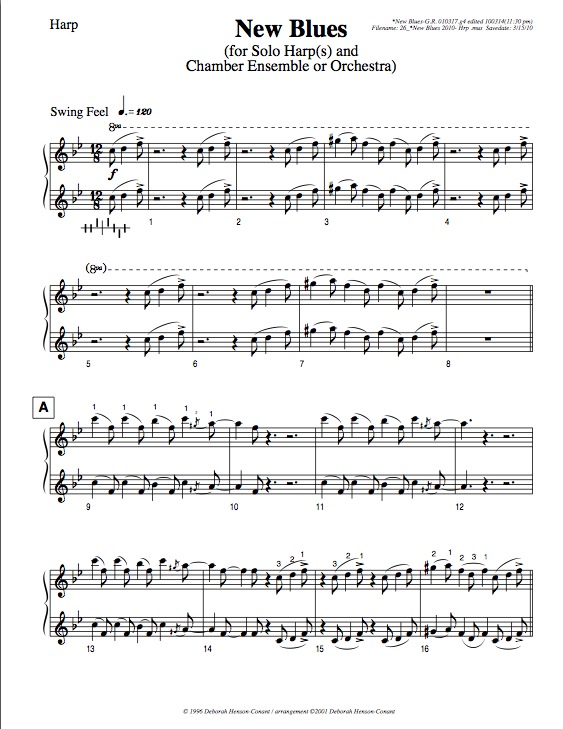New Blues
This piece isn’t officially part of “World Harp Ensemble” yet, but it IS part of the ‘Harp-Breaker’ project. There’s no tutorial video, because the music itself is pretty straightforward, you can hear a performance of it and download the manuscript and play-along files.
Files to Download
(Note: Don’t try to print the music at the left. The music to download is at the bottom of this page)
If you right-click or option-click the links below you should be able to save them to your computer – at least, that’s how it works on a MAC – hopefully it works similar on PCs. Enjoy!
Sheet Music
- Sheet Music: Print Back-to-Back starting with the cover page to facilitate page turns
- MP3 Audio File #1: With midi instruments. This is about the tempo we’ll actually play it. We may play just a touch faster. (NOTE: m. 75-82 sound different on the audio than what’s written. Play what’s written – but remember that you’re tacet in 75-78). Don’t worry about the “2nd Harp” – I was playing along during the recording – just ignore that part for now.
- MP3 Audio File #2 (slower): SLOWER with midi instruments & only your part. This is slower than we’ll play it, but it’s great for practicing.
(Remember to leave measures 75-78 tacet even though you hear them played on the MP3)
Notes
- Printing out the music: If possible, print the music “double sided” starting with the cover page, to print page turns correctly. If you print single-sided, there’s no need to print the cover page.
- Errata: Do not play in m. 75, 76, 77 & 78. Those measures are tacet.
- Key / Levers / Pedals: Even though the piece is in Bb, make sure you raise your G(s) to G#. So your key signature is: Bb Eb and G#. Once you set your harp up that way, there should be NO lever or pedal changes through the whole piece.
- For lever harps in Eb, just raise G’s and A’s.
- Tempo / Meter: The meter is 12/8 so the metronome beats 4 to every bar — and every beat is subdivided into 3 (kind of like 4 triplets in each bar)
- Doubling / Simplifying: Most of the melody is doubled in octaves. If you’re more of a beginner and need to play only one line, that’s fine. Don’t worry about playing absolutely everything. What’s important is to play “with” the ensemble, so even if you play just the first note of the faster runs, it’s fine — more advanced players will play the rest, and your one note will add important emphasis.
- 12-Bar Blues Form: The normal 12-Bar Blues starts at Letter C. Before then, the piece is a kind of modified Blues form. At letter D, you “lay out” (are tacet) for 12 bars (or maybe 24, or 36) — just like you would in the Blues if players were taking “solos.”
- Count-in: On the playback-mp3 there are two measures of of count-in and you come in on an upbeat, so you’ll hear the following beats (but not these words): One-Two-Three-Four | One-Two-Three And Your In! In performance we may have a musical introduction, but I’ll also count it in loud and clear.
Sheet Music
- Sheet Music: Print Back-to-Back starting with the cover page to facilitate page turns
- MP3 Audio File #1: With midi instruments. This is about the tempo we’ll actually play it. We may play just a touch faster. (NOTE: m. 75-82 sound different on the audio than what’s written. Play what’s written – but remember that you’re tacet in 75-78). Don’t worry about the “2nd Harp” – I was playing along during the recording – just ignore that part for now.
- MP3 Audio File #2 (slower): SLOWER with midi instruments & only your part. This is slower than we’ll play it, but it’s great for practicing.
(Remember to leave measures 75-78 tacet even though you hear them played on the MP3)


